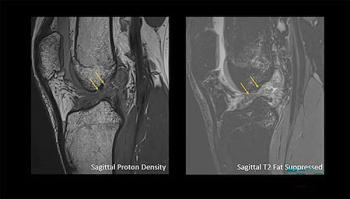An emerging deep learning model utilizing chest X-ray assessment correctly detected osteoporosis in over 75 percent of patients based on subsequent dual-energy X-ray absorptiometry (DXA) findings, according to new research.
For the randomized controlled trial, recently published in Radiology, researchers developed a deep learning model for identifying people at high risk for osteoporosis based on chest X-ray assessment. According to the study, the deep learning model was trained on 25,574 chest radiographs and external validation testing revealed an area under the receiver operating characteristic curve (AUROC) of 89 percent.
Utilizing the deep learning model to analyze 91,911 chest X-rays from 40,658 study participants, the study authors noted the model identified 4,912 people (12.1 percent) as being at high risk for osteoporosis. The researchers subsequently compared 2,456 of those participants who were offered fully reimbursed DXA vs. 2,456 participants who received usual care.
Noting that 315 out of the 2,456 participants agreed to proceed with DXA screening, the study authors found that 237 people (75.2 percent) had new-onset osteoporosis, which was defined as a T score < -2.5. When evaluating DXA results and usual care in the screening and control groups, the researchers noted a 10 percent higher rate of osteoporosis detection in the screening group (11.1 percent vs. 1.1 percent).
“ … This randomized controlled trial highlights the potential of dual-energy x-ray absorptiometry screening for patients with incidental osteoporosis identified by an opportunistic artificial intelligence (AI)–enabled chest radiography analysis, which facilitates appropriate diagnostic and treatment interventions,” wrote lead study author Chin Lin, Ph.D., an associate professor with the Medical Technology Education Center within the School of Medicine at the National Defense Medical Center in Taipei, Taiwan, and colleagues.
The researchers also pointed out that those in the screening group who did not meet International Society for Clinical Densitometry (ISCD) criteria for DXA screening had over a 15 percent higher odds ratio (OR) for being diagnosed with osteoporosis in contrast to those in the cohort who did meet ISCD criteria (23.2 OR vs. 8.0 OR).
“In the absence of traditional risk factors, the ISCD indications for DXA testing only encompass women over 65 and men over 70 years of age. However, after AI-enabled chest radiography stratification, high-risk participants who did not meet ISCD indications still had 70.2 percent confirmed as having osteoporosis through DXA testing in our study,” noted Lin and colleagues.
Specifically, the study authors found that DXA screening revealed average risk ratios of 2.10 and 7.04, respectively, for 10-year major osteoporosis risk and hip fracture risk among participants who did not meet ISCD criteria. In contrast, participants who did meet ISCD criteria had a 10-year major osteoporosis risk ratio of 1.38 and a hip fracture risk ratio of 1.85, according to the researchers.
Three Key Takeaways
1. High detection rate. The deep learning model successfully detected osteoporosis in over 75 percent of patients, aligning well with subsequent DXA findings.
2. Enhanced screening. Utilizing AI-enabled chest radiography analysis facilitated a 10 percent higher detection rate of osteoporosis compared to usual care, demonstrating the potential for more effective opportunistic screening.
3. Opportunistic screening beyond International Society for Clinical Densitometry (ISCD) criteria for DXA screening. The model identified individuals at high risk for osteoporosis who did not meet traditional ISCD screening criteria, with a significant percentage (70.2%) confirmed as having osteoporosis through DXA testing. This indicates the model's utility in identifying at-risk individuals who might be missed due to conventional screening criteria.
(Editor’s note: For related content, see “FDA Clears CT-Based AI Tool for Detecting Vertebral Compression Fractures,” “AI Software for X-Rays Gets FDA De Novo Classification for Bone Mineral Density Screening” and “OsteoSight Gets FDA Breakthrough Device Designation for Bone Mineral Density Assessment on X-Rays.”)
In an accompanying editorial, Andrew D. Smith, M.D., and Steven A. Rothenberg, M.D., expressed concern about the approximately 25 percent false-positive rate and patient distrust with the deep learning model. However, they also noted the viability of the model for bolstering opportunistic detection of osteoporosis beyond current screening approaches.
“This innovative approach has the potential to identify individuals at high risk for osteoporosis who might otherwise be missed with traditional screening criteria or methods.,” noted Dr. Smith, a professor and chair of the Department of Radiology at St. Jude Children’s Research Hospital, and Dr. Rothenberg, an assistant professor in the Cardiopulmonary Section and Imaging Informatics Division within the Department of Radiology at the University of Alabama at Birmingham.
In regard to study limitations, the authors acknowledged that data was drawn from a single center and from electronic medical records that may have had incomplete information. They also noted no blinding for control group participants and conceded that only 14.6 percent of patients had the DXA testing.





























